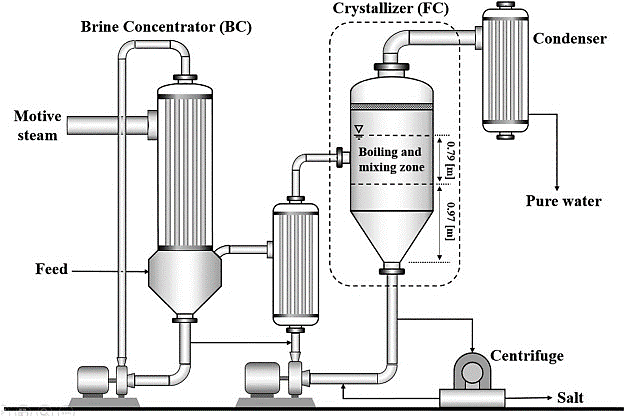
Crystallization is a physical change. Crystallization is the formation of solids from the liquid or gaseous phase. This technique includes obtaining the crystals of a soluble substance from a hot saturated solution and separating the soluble solid from the solution.
To concentrate feed into solid crystals and clean water, crystallizers are used. A progressively harder method for which crystallite sizes are formed from a liquid solution is known as crystallization. Crystallizers can remove liquid wastes completely, resulting in no liquid discharge (ZLD). The process continues and secondary crystallization are the two stages of crystallization. The formation of new crystals is referred to as primary nucleation. Secondary nucleation is the primary stage that results in the mass production of crystals. There are two types of crystallization processes: evaporative crystallization and cooling crystallization.
Evaporative crystals are Employed in the entire process of evaporative crystallization. Via this crystallizer, the solvent evaporates bringing about a rise in the concentration of the answer.
We then elucidated the criterion of crystallizability and confirmed the way it will depend on salt species, membrane properties and working problems. And finally, we analysed the Vitality consumption of the EDC-reverse osmosis cure teach for accomplishing zero liquid discharge of a Na2SO4 brine. All round, this analyze presents a proof of strategy for EDC as an electric-subject pushed and non-evaporative crystallization procedure, and lays the foundation for its future complex improvement and optimization.
) from dissolved solids in an answer. This separation frequently will involve concentration of brine and recovery of large-high-quality drinking water for effective reuse. Evaporation is usually employed when membrane systems turn out to be impractical at bigger concentrations of complete dissolved solids (TDS).
a The drinking water evaporation rate with the solar crystallizer working with concentrated SWRO brine with 8.4‰ NTA; b Picture graphic on the solar crystallizer and gathered salt following 24-h operation; c Photograph graphic of the photo voltaic crystallizer just after getting rid of accrued salt right after 24-hour operation; SEM photographs of d QGF membrane just after 24-h operation and e the salt crystals gathered in the outer surface; f Image picture with Crystallizer Manufacturer Crystallizer For Zero Liquid Discharge System the solar crystallizer and self-defoliated salt following forty eight-h Procedure (the crimson dotted body represents the situation of removed solar crystallizer); g the water evaporation rate of your solar crystallizer in the 288-h Procedure (Every single position within the curve was the typical evaporation level of 24 h).
To substantiate the lengthy-term operational stability, the solar crystallizer was continually illuminated from the simulated daylight (1 kW m−2) for 288 h in lab conditions to treat concentrated SWRO brine with NTA. There was no handbook salt removal through the photo voltaic crystallizer and only the self-defoliated salt crystals ended up periodically collected during the operation. Through the entire tests period, the performance of your photo voltaic crystallizer was largely secure and a median evaporation charge of two.
Calandria Crystallizer with Salt Basket: A calandria crystallizer could be utilised for small circulation purposes. The heater is housed In the vapour system, leading to a compact style and design. Minimal-tension steam is used to power the calandria crystallizer. The vapour is either condensed or released in to the environment. The condensing steam (shell aspect) provides up its latent heat to the growing liquid by using a propeller pump placed in The underside fifty percent on the crystallizer.
These typical approaches are actually proved to acquire harmful effects on aquatic ecosystems and land vegetation systems11,twelve,13,fourteen. Therefore, with ever tightening environmental laws and raising general public environmental recognition, these direct or semi-immediate disposal from the waste brines is dealing with potent criticism. As an ambitious goal for brine cure, the thought of zero liquid discharge (ZLD) has gained renewed attentions recently, as it aims to do away with all squander liquid and deliver sound salts as the one byproduct7,eleven,15.
content articles printed less than an open accessibility Resourceful Prevalent CC BY license, any A part of the short article may very well be reused without
The authors declare that the info supporting the results of this review can be obtained in the authors upon ask for.
A number of crystals are formed when crystallizers are melted. Nearly all the solution or soften (usually > 90%) crystallizes in suspension or on a cooled area. The minimal amount of uncrystallized mom liquor retains impurities.
Steam Pushed: The amount of evaporation for each pound of steam utilized is all over 1 pound, which might lead to high working costs. The vapour established need to even be condensed, which necessitates the usage of cooling water.
We use cookies that can help present and enhance our provider and tailor written content and adverts. By continuing you agree to using cookies.
) Get well additional h2o for reuse and crank out a crystalline products well suited for landfill disposal.
The hollow cone-formed buoyant layer was developed parametrically by CAD. The middle with the buoyancy layer holds the crystallizer, along with the concave groove with the buoyancy layer collects the dislodged salt crystals. The buoyancy layer also functions being an insulator, lowering the warmth transfer involving the crystallizer as well as brine. In accordance with the buoyancy system (one) and the particular structure facts with the buoyancy layer, it may be calculated that the volume of brine discharged by the buoyancy layer was 158.